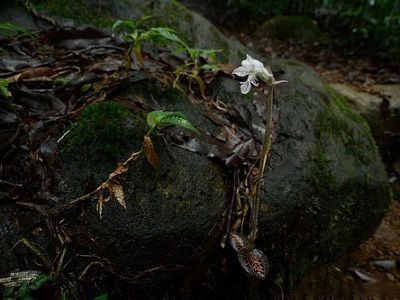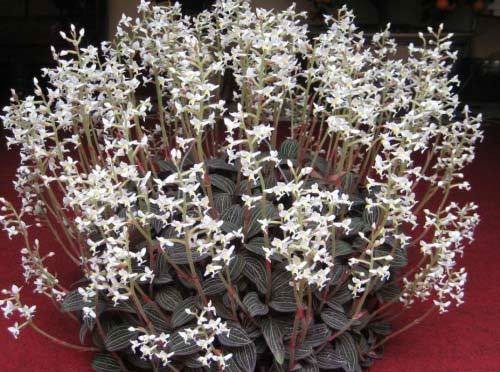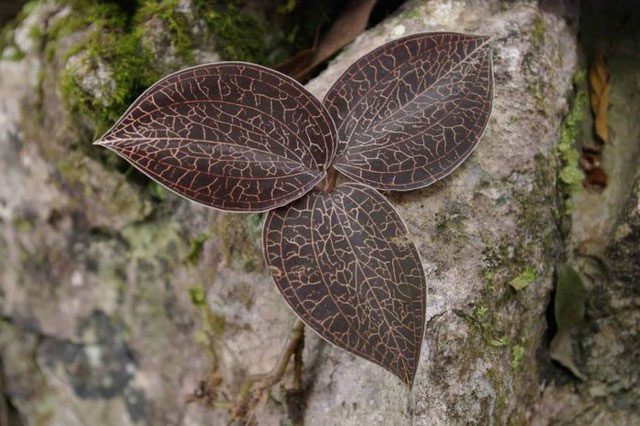Due to excessive hunting, this rare grass has fallen into the risk of extinction.
The Sought-After Grass
Between 2018 and 2021, many Chinese traders flocked to villages in Binh Lieu District, Quang Ninh Province to purchase a type of wild grass that they claimed was a miracle herb. Prices for this grass sometimes soared to hundreds of millions of Vietnamese Dong per kilogram, prompting many locals to rush into the forests in search of it.
Not only found in Binh Lieu, in 2012, numerous traders also sought to buy large quantities of this grass in some communes such as Huong Trach, Phuc Trach, Huong Lam, and Huong Lien in Ha Tinh Province.
According to VTC News, it wasn’t just Chinese traders; many Japanese merchants were also willing to spend significant amounts of money to purchase them after they had been dried.
What kind of grass is this that commands such high prices?

Anoectochilus is the grass sought after by many traders from China and Japan. (Photo: Thai Son Medicinal Materials)
In an article on Vietnamnet, the grass in question is called Anoectochilus, which is abundant in Vietnam. Anoectochilus (scientific name: Anoechilus roxburghii Hayata) belongs to the Orchidaceae family. It is also known by various names such as: diamond grass, velvet grass, kim tuyen lien, brocade orchid, or muoc son thach tung…
The name is derived from its velvet purple leaves, with a light pink underside and clearly visible veins that give a soft and smooth feel. Observers often notice that the leaf veins shimmer as if adorned with glitter. The stem of the plant is segmented.
Anoectochilus is a herbaceous plant with long roots that penetrate the soil. The length of the roots depends on the size of the plant, with an average of 2 to 10 roots per Anoectochilus plant.

The veins of Anoectochilus shimmer as if adorned with glitter. (Photo: VNUA).
The leaves of the plant grow in an egg shape, with a round base that becomes pointed towards the tip. The leaves typically spiral around the stem, spreading along the ground and measure approximately 3-6 cm in size. This plant thrives in high humidity and shade, dislikes direct sunlight, and requires rich, loose, and well-aerated soil.
Anoectochilus grows on cliffs, along streams, and beneath large canopies in moist forests at altitudes of 500 to 1,600 meters. It is often found growing singly or in scattered clusters in the high mountain regions of Vietnam. Additionally, it can also be found in Laos, Thailand, China, India, and Nepal.

Anoectochilus grows on cliffs, along streams, and beneath large canopies in moist forests at altitudes of 500 to 1,600 meters. (Photo: LIFE GIFT)
Most species of Anoectochilus are precious. Some species hold significant value in the ornamental plant world, such as the well-known Anoectochilus albo-lineatus, which is featured in all botanical magazines. Currently, approximately 15 species have been identified in Vietnam, of which only 2 are considered highly valuable medicinal plants: Anoectochilus formosanus Hayata and Anoectochilus roxburghii. These species thrive along the Hoang Lien Son and Truong Son mountain ranges.
A Grass with Valuable Medicinal Properties
According to Dan Tri, Anoectochilus is one of the precious medicinal plants in Vietnam, due to its diverse pharmacological effects and high economic value. In the book “Vietnamese Medicinal Plants Dictionary,” Volume I, page 1251 states: “In Yunnan (China), Anoectochilus is used to treat pulmonary tuberculosis, cough due to lung heat, rheumatism, joint pain, and chronic gastritis.”
According to the Chinese book “Bencao Gangmu”, Anoectochilus is regarded as the king of herbs, known for its functions in cooling the liver, clearing heat, detoxifying, alleviating dry cough, sore throat, hemoptysis, abdominal pain, high fever, and enhancing immunity…

Anoectochilus is one of the precious medicinal plants in Vietnam, due to its diverse pharmacological effects and high economic value. (Photo: VNUA)
Western researchers have found that when tested on diabetic mice, Anoectochilus has the potential to combat hyperglycemia from polysaccharides. They administered two doses of 100 or 300 mg/kg of polysaccharides once a day for 25 days. The results showed that compared to untreated diabetic mice, those given the treatment experienced significant reductions in pathological damage in the pancreas and liver, with notable improvements in the function of both organs.
Additionally, Anoectochilus is known for its ability to restore damaged stem cells and is commonly used to treat diabetes, kidney stones, and bronchitis.
A U.S. patent, US 7033617 B2, describes “The use of extracts from the Anoectochilus plant as herbal nutritional supplements to prevent chemical harm or treat malignant tumors in humans.”
In 2015, U.S. scientists announced the patent US 9072770 B2 stating, “The aqueous extract of the Anoectochilus plant is useful for liver protection.”

Anoectochilus is at risk of extinction due to overharvesting. (Photo: SFARM)
However, due to overharvesting, Anoectochilus was included in the list of endangered medicinal plants by the Chinese government in the 1990s.
With its valuable medicinal properties, Anoectochilus is purchased at a high market price, exceeding 100,000,000 VND per kilogram of dried product. Due to its scarcity, scattered growth, and excessive harvesting (often involving the uprooting of entire plants), this grass was listed in the Vietnam Red Book in 2007 under Decree 32/2006/ND-CP, categorized as EN A1a,c,d, and its commercial harvesting and use are banned.
Scientists have successfully selected, preserved, and cultivated Vietnamese Anoectochilus in the Langbian Plateau, Lam Dong, and several other regions.


















































